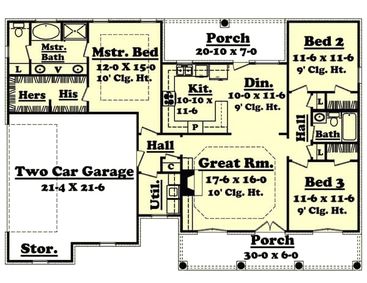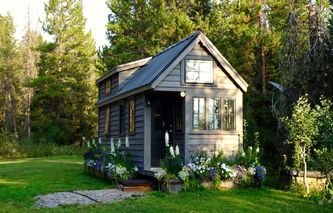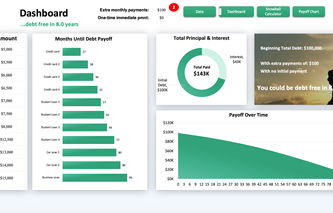You’re standing in an empty field with your hard-earned cash, ready to finally build that dream house you’ve been dreaming of. But then the question pops up in your head—
What’s the average cost to build a 1,500 square foot house right now?
Post-pandemic shortages, skyrocketing material prices, unreliable builders—it all suddenly feels overwhelming.
Navigating the world of homebuilding in 2023 can feel like playing a game of real estate roulette.
We’re here to help you with a breakdown of the average costs and crucial factors involved in constructing your very own 1,500-square feet palace.
The costs of building your own 1,500 square foot house by state.
How much land you’ll need, and how much it’ll cost you.
How long it takes, and what factors you need to consider.
If you should buy a ready-made house instead.
Related:
How Long Does It Take to Build a House? (Detailed House Building Timeline 2024)
How Much Money Should I Save Before Buying a House: A Detailed Breakdown
Should I Buy a House Now or Wait Until 2024? (When Is The Worst Time?)
Mortgage Payoff Calculator: How to Pay Off Mortgage in 5 Years
What’s the Average Cost To Build a Home In 2023?
The average cost of buying a lot of land (0.15 acres), building a 1,500 sq ft house, and hiring an architect comes to around $263,877.

The construction costs are—on average—between $150,000 and $232,500.
This breaks down to between $100 and $155 per square foot. The exact cost depends mainly on location. And remember, this price doesn’t include the land.
(The average cost for a buildable lot of land is $62,626—with states like Hawaii, California, and New York inflating the average.)
How Much Land Do You Need to Build a 1500 Sq Ft House?
The amount of land needed to build a 1,500 sq ft house depends on various factors—such as the layout, design, local zoning laws, and any additional outdoor space you desire.
A suitable minimum lot size for a 1,500 sq ft house ranges from 0.10 to 0.15 acres (4,356 to 6,534 sq ft).
This size allows for setbacks as required by local regulations, along with some yard space.
How much will you pay for that land?
Looking at the standard city lot in the US (0.15 acres), you’d have to pay an average of $62,626 for the land itself.
That’s based on the average price of $417,512.00 per acre—but keep in mind that land prices vary depending on where you live.
You’d pay almost $400,000 per acre in New York ($391,125) but less than $10,000 in Mississippi ($8,820).
Land and House Construction Costs by State in 2023
A 1,500-square-foot house represents the perfect balance between spaciousness and practicality, offering you a canvas for dreams to take shape, both large and small.
A house of this size typically includes three bedrooms, two bathrooms, and versatile living spaces that harmonize shared moments and much-needed solitude.
It might look something like this—

Now, the cost of building a 1,500 sq ft house (between $150,000 and $232,500) and the cost of 0.15 acres of land ($62,626) equals an average total of between $212,626 and $295,126.
That’s the national average.
How do these costs compare across states?
STATE | BUILD OF 1,500 SQ FT | 0.15 ACRES (LOT) | AVERAGE PRICE OF LAND AND BUILD |
Alabama | $200,715.00 | $11,850.00 | $212,565.00 |
Alaska | $315,810.00 | $43,620.00 | $359,430.00 |
Arizona | $221,685.00 | $50,790.00 | $272,475.00 |
Arkansas | $188,850.00 | $10,980.00 | $199,830.00 |
California | $304,080.00 | $371,055.00 | $675,135.00 |
Colorado | $224,475.00 | $102,960.00 | $327,435.00 |
Connecticut | $259,080.00 | $35,430.00 | $294,510.00 |
Delaware | $245,295.00 | $36,525.00 | $281,820.00 |
Florida | $197,730.00 | $61,365.00 | $259,095.00 |
Georgia | $205,395.00 | $21,495.00 | $226,890.00 |
Hawaii | $309,630.00 | $413,385.00 | $723,015.00 |
Idaho | $236,640.00 | $40,725.00 | $277,365.00 |
Illinois | $199,080.00 | $56,505.00 | $255,585.00 |
Indiana | $164,475.00 | $15,975.00 | $180,450.00 |
Iowa | $160,530.00 | $21,150.00 | $181,680.00 |
Kansas | $155,340.00 | $20,565.00 | $175,905.00 |
Kentucky | $210,435.00 | $20,640.00 | $231,075.00 |
Louisiana | $202,440.00 | $37,905.00 | $240,345.00 |
Maine | $211,605.00 | $22,635.00 | $234,240.00 |
Maryland | $220,620.00 | $75,480.00 | $296,100.00 |
Massachusetts | $263,115.00 | $118,335.00 | $381,450.00 |
Michigan | $162,585.00 | $23,325.00 | $185,910.00 |
Minnesota | $177,735.00 | $41,250.00 | $218,985.00 |
Mississippi | $191,490.00 | $8,820.00 | $200,310.00 |
Missouri | $170,070.00 | $20,430.00 | $190,500.00 |
Montana | $224,220.00 | $30,450.00 | $254,670.00 |
Nebraska | $158,175.00 | $25,200.00 | $183,375.00 |
Nevada | $250,605.00 | $63,885.00 | $314,490.00 |
New Hampshire | $224,925.00 | $24,285.00 | $249,210.00 |
New Jersey | $282,675.00 | $125,235.00 | $407,910.00 |
New Mexico | $218,205.00 | $30,060.00 | $248,265.00 |
New York | $270,135.00 | $391,125.00 | $661,260.00 |
North Carolina | $226,125.00 | $21,195.00 | $247,320.00 |
North Dakota | $159,375.00 | $25,530.00 | $184,905.00 |
Ohio | $166,860.00 | $20,955.00 | $187,815.00 |
Oklahoma | $195,375.00 | $18,435.00 | $213,810.00 |
Oregon | $255,435.00 | $92,880.00 | $348,315.00 |
Pennsylvania | $226,650.00 | $46,755.00 | $273,405.00 |
Rhode Island | $253,635.00 | $53,520.00 | $307,155.00 |
South Carolina | $226,380.00 | $22,470.00 | $248,850.00 |
South Dakota | $153,315.00 | $22,035.00 | $175,350.00 |
Tennessee | $196,455.00 | $18,645.00 | $215,100.00 |
Texas | $198,075.00 | $40,260.00 | $238,335.00 |
Utah | $216,420.00 | $73,635.00 | $290,055.00 |
Vermont | $230,880.00 | $47,175.00 | $278,055.00 |
Virginia | $232,575.00 | $81,300.00 | $313,875.00 |
Washington | $257,325.00 | $104,820.00 | $362,145.00 |
West Virginia | $225,840.00 | $10,695.00 | $236,535.00 |
Wisconsin | $179,355.00 | $26,955.00 | $206,310.00 |
Wyoming | $217,815.00 | $30,645.00 | $248,460.00 |
Source: https://app.home-cost.com/construction-cost-per-sf.html#try
When you look at the data, you’ll spot the obvious differences in cost by region:
The Northeast has the highest average prices—including New York, Massachusetts, and New Jersey.
The West has relatively high average prices—including California, Hawaii, and Washington.
The South has moderate prices—including Texas, Louisiana, Florida, Georgia, and North Carolina.
The Midwest has the lowest average prices—including South Dakota, Kansas, and Nebraska.
The cost of buying land and building homes can vary a lot depending on where you are. Local economies, labor costs, material availability, and the demand for housing can all play a part in why costs can swing so much.
Of course, these are just general trends, and there are always exceptions. In fact, even different regions within the same state can have different costs based on all kinds of factors.
Cost to Build a House If You Already Own the Land
Let’s assume you already own the land—
Then ask yourself: Are you capable of designing your own house, or do you need professional help? Are you okay with choosing from pre-designed plans, or do you want to create the custom home of your dreams?
Design and architectural fees—understanding the design process
Building a home is a long ride, but it all begins with an idea. Whether it’s yours or you leave it to the professionals—it’s up to you.
It’s usually recommended that you hire an experienced architect to draw an exact plan for the house.
Depending on the regional prices and availability of design firms, it can cost anywhere from $2 to $15 per square foot.
See the table below for the average fees you can expect, depending on how you’d like to work with your architect—
FEE | AMOUNT |
Fixed fee (drawing plans) | $2,000–$20,000 |
Fixed fee (full service) | $15,000–$80,000+ |
Hourly rate | $100–$250 |
Source: https://homeguide.com/costs/architect-cost
A custom-designed abode tailored to your dreams typically comes with a heftier price tag than if you bought a standard house in a subdivision or worked with a developer offering pre-designed floor plans.
Next, think about the most pricey bit of building a house—the materials.
Construction materials’ cost to build a house
A big chunk of your home-building budget will probably go towards materials (cue the bank-breaking sound effect).
HomeAdvisor says these can set you back around $50 per square foot—so to build a 1,500 sq ft house, you’d spend around $75,000 on materials alone (which, of course, will vary based on location and other factors).
Labor cost to build a house
The same goes for labor costs, which will be significantly different in rural or urban locations, depending on the complexity of the project and labor market conditions.
In the United States, the current average labor cost ranges from $50 to $125 per square foot.
If we put the data together, we’ll get the following house price breakdown—
ITEM | COST |
Materials | $75,000 |
Labor | $115,000 |
Average total | $190,000 |
Then you need to add the cost of the land and architect fees to it.
ITEM | COST |
Construction cost (including materials, labor, inspection fees, etc.) | $190,000 |
Land (0.15 acres) | $62,626 |
Design | $11,250 |
Average total | $263,877 |
That gives you an average of around $263,877.
Cost Breakdown of Building a House
Now, let’s see the exact breakdown of construction costs by job.
The grand total for a 1,500-square-foot house worth $190,000 (so between an average of $150,000 and $232,000 mentioned above) includes building permit fees, inspection fees, labor, and materials.
(We used the latest edition of NAHB’s Cost of Constructing a Home study and the average mid-point house price.)

The breakdown features only the construction costs, assuming you already own the land and have your house designed.
PROJECT | AMOUNT (%) | COST |
Site work | 7.4% | $14,060 |
Foundation | 11.0% | $20,900 |
Framing | 20.5% | $38,950 |
Exterior finishes | 11.8% | $22,420 |
Major systems | 17.9% | $34,010 |
Interior finishes | 24.0% | $45,600 |
Final steps | 5.9% | $11,210 |
Other | 1.5% | $2,850 |
Construction costs | 100% | $190,000 |
Land development and site work—7.4% of the total cost
The initial stages involve lot preparation, permits, impact fees, and inspections.
SITE WORK | AMOUNT (%) | COST |
Building permit fees | 2.10% | $3,990 |
Impact fee | 1.30% | $2,470 |
Water & sewer fees inspections | 1.50% | $2,8500 |
Architecture | 1.20% | $2,280 |
Other | 1.30% | $2,470 |
Total average cost | 7.40% | $14,060 |
Let’s continue with our example to see what construction costs you’ll have to cover to lay the foundations, do the framing, roofing, and so on.
Laying the foundations for the house—11% of the total cost
FOUNDATIONS | AMOUNT (%) | COST |
Excavation, foundation, concrete, retaining walls, and backfill | 10.10% | $19,190 |
Other | 0.90% | $1,710 |
Total average cost | 11.00% | $20,900 |
Framing the construction, including the roof—20.50% of the total cost
The third step in building a house is framing it (over one-fifth of the entire build cost).
FRAMING | AMOUNT (%) | COST |
Framing (including roof) | 15.50% | $29,450 |
Trusses | 2.90% | $5,510 |
Sheathing | 1.40% | $2,660 |
General, metal | 0.30% | $570.00 |
Other | 0.40% | $760.00 |
Total average cost | 20.50% | $38,950.00 |
Exterior finishes—11.80% of the total cost
Next on the list are exterior finishes, including roofing, putting windows and doors in, and finishing the exterior wall.
EXTERIOR FINISHES | AMOUNT (%) | COST |
Exterior wall finish | 5.00% | $9,500.00 |
Roofing | 2.90% | $5,510.00 |
Windows and doors | 3.40% | $6,460.00 |
Other | 0.40% | $760.00 |
Total average cost | 11.80% | $22,420.00 |
Essential rough-ins for major systems in a 1,500 sq ft house construction—17.9% of the total cost
When building a 1,500 sq ft house, several major systems will need rough-ins during the building process.
These include the electrical system (installing electrical boxes, conduits, and wiring), the plumbing system (laying out pipes for water supply, waste, and vent lines), and the HVAC system (ductwork installation, placement of vents and registers, and setting up the furnace and air conditioning units).
You should also install rough-ins for gas lines, if applicable, for appliances like stoves, water heaters, and fireplaces.
MAJOR SYSTEMS ROUGH-INS | AMOUNT (%) | COST |
Plumbing | 5.80% | $11,020.00 |
Electrical | 6.10% | $11,590.00 |
HVAC | 5.60% | $10,640.00 |
Other | 0.40% | $760.00 |
Total average cost | 17.90% | $34,010.00 |
Interior finishes in a 1,500-square-foot house—24% of the total cost
Let’s get inside your new house. The interior finishes can take up almost $50,000:
INTERIOR FINISHES | AMOUNT (%) | COST |
Insulation | 1.70% | $3,230.00 |
Drywall | 3.40% | $6,460.00 |
Interior trims | 3.20% | $6,080.00 |
Painting | 2.20% | $4,180.00 |
Lighting | 1.10% | $2,090.00 |
Cabinets | 4.50% | $8,550.00 |
Appliances | 1.60% | $3,040.00 |
Flooring | 3.30% | $6,270.00 |
Plumbing fixtures | 1.30% | $2,470.00 |
Fireplace | 0.40% | $760.00 |
Other | 1.20% | $2,280.00 |
Total average cost | 24.00% | $45,600.00 |
We’re almost there. All that’s left is to do the finishing touches—
Finishing touches (customizations vs. standard options)—5.9% of the total cost
Again, depending on your preferences, the house’s final look (and cost) may be a lot different.
The example we’re using includes the basic elements only:
FINAL STEPS | AMOUNT (%) | COST |
Landscaping | 2.30% | $4,370.00 |
Outdoor structures | 0.60% | $1,140.00 |
Driveway | 2.20% | $4,180.00 |
Clean up | 0.60% | $1,140.00 |
Other | 0.20% | $380.00 |
Total average cost | 5.90% | $11,210.00 |
The last $2,850 (1.5%) of the total cost goes to miscellaneous expenses.
Unforeseen expenses—creating a contingency plan
Embarking on the journey of building a home can be both exciting and challenging, especially with unforeseen expenses.
To tackle these unexpected costs, it’s crucial to establish a contingency plan.
It should include setting aside a financial buffer, typically around 10–15% of your total construction budget, to cover any surprises that may pop up during the building process.
By having a contingency plan in place, you’ll be better prepared to handle any hiccups, such as material price fluctuations, labor shortages, or unforeseen site conditions, without derailing your project or causing unnecessary stress.
In the end, a well-crafted contingency plan will help ensure a smoother and more enjoyable home-building experience.
Building a Home: Questions Answered
How long does it take to build a 1500 sq ft house?
We can’t give you a reliable estimate because it’ll depend on where you are, the weather, crew size, and the permit approval process.
Custom design elements, unexpected delays, or changing your mind on materials or finishes can add to the overall time.
On average, expect the timeline to range between nine and twelve months for your new home to be built—but it can take up to 24 months if any delays happen.
Learn more on how long it takes to build a house.
Is it expensive to build a house?
Yes, building a house is expensive. The final cost will depend on where you live, how big the house will be, and stuff like that.
On average, building a townhouse can set you back about $150,000 to $300,000 or even more (assuming you already own the land).
How much does it cost to build a 3-bedroom house?
On average, the construction cost ranges from $100 to $200 per square foot.
For a typical 3-bedroom house size of approximately 1,500 to 2,000 sq ft, the total cost might range from $150,000 to $400,000 or more.
To have a full picture of the budget, though, you’d have to add the cost of land.
What’s the cheapest 1500 sq ft house to build?
The cheapest 1500 sq ft house to build would likely be a simple, single-story design with an open-concept layout that minimizes the need for complex structural elements.
To keep costs low:
Opt for affordable building materials like vinyl siding, asphalt shingles, and standard-grade fixtures and finishes.
Use local materials to save some cash on transportation costs.
Ditch custom or fancy stuff and stick to a “no-frills” approach.
What’s the average cost to build a 1500 sq ft house by yourself?
If you’re up for some DIY, building a 1,500 sq ft house by yourself could save you a ton of money on labor costs.
Assuming you can handle most of the work yourself and have some basic construction skills, the cost of materials and all the other stuff you’ll need can be roughly around $70 to $100 per square foot.
This means for a 1,500 sq ft house, you’re looking at the cost of about $105,000 to $150,000 (give or take).
That doesn’t include the cost of the land—and your actual cost might differ depending on where exactly you’re building, which design elements you choose, and whether you need to bring in professionals for tricky jobs like plumbing or electrical work.
House Construction Costs by State in 2023
As you can see, the average cost to build a 1,500 square foot house of around $190,000 was just an example.
Every project will bring individual surprises, issues, and costs.
That being said, if we look at the average cost for different states, location is perhaps the biggest factor affecting the entire cost of building a house.
Keep in mind that rural Washington was (and always will be) way different from, say, building in the DC area itself.
The average cost to build a 1,500 sq ft house in California
Building a 1,500 sq ft house in California comes with its own unique charm and, of course, a price tag.
On average, you can expect to invest around $304,080 to construct your dream dwelling in this sun-soaked paradise, including materials, labor, and other construction-related expenses.
The average cost to build a 1,500 sq ft house in Florida
Building a 1,500 sq ft house in Florida offers the perfect blend of tropical vibes and modern living.
You’ll need to budget, on average, around $197,730 to make it happen.
This amount covers the essentials like materials, labor, and other construction-related costs.
The average cost to build a 1,500 sq ft house in Minnesota
In the Land of 10,000 Lakes, Minnesota, building a 1,500 sq ft house comes with a fairly reasonable cost.
On average, you’ll need to allocate around $177,735.
To see the average house price of all states, see the table above.
Conclusion: The Average Cost to Build a 1,500 Square Foot House
Now you have a much better idea of how much it would cost you to build a 1,500-square-foot house.
The average cost of $263,877 won’t be the case for everyone—but it’s useful to know the national average and compare prices by state.
Before embarking on the home-building journey, remember to negotiate with contractors, suppliers, and other specialists to get the best value for your money.
Matt Little, a real estate specialist, suggests studying many possibilities and comparing prices to find the best deal:
“Negotiate and seek reductions, especially if you’re paying in advance. Working with competent and experienced individuals with a proven track record is critical. You can also check online reviews or ask for references to guarantee their authenticity.
While choosing materials, consider durability, quality, and cost-effectiveness. To lower your carbon footprint and save money in the long term, use eco-friendly and energy-efficient materials.”
Building a 1,500 Sq Ft House—Is It Worth It?
Usually, it’s the other way round, but new research shows that in more than one-third of states, it’s actually cheaper to build a house than buy one (including in California, Colorado, Maryland, Montana, Florida, and Idaho).
On the other hand, in Pennsylvania, Illinois, Missouri, Michigan, South Dakota, Indiana, and West Virginia (to name just a few), it’s much more cost-effective to buy a ready-made home.
So, depending on where you would like to live and what are your current and future needs, it’s up to you to figure out if it’s worth building a house.
Perhaps this chart will help you make the decision—
A three-bedroom abode of 1,500 sq ft, with a garage and yard on a lot of land, seems like a good idea for a small to medium-sized family.
Choosing to build a 1,500 sq ft house rather than buying one can be a great decision for a few reasons—
First, you get the chance to create a home that’s tailored to your specific tastes and needs, making it truly unique and personalized.
Newly built homes also tend to be more energy efficient, which means you’ll save on utility bills and be kinder to the environment.
You’ll also enjoy the perks of having a brand-new home with fewer maintenance issues, giving you more time to relax and enjoy your space.
Depending on the location, a smaller, custom-built home might have a higher resale value compared to existing homes, making it a smart investment.
So, while building a 1,500 sq ft house might require more upfront effort and costs, the long-term benefits can definitely make it worth considering.
Downsides of Building Instead of Buying a House
To give you the full picture, let’s look at some downsides of building rather than buying a house—
Higher upfront costs
Building a new home can be more expensive initially because of costs such as land purchase, permits, and construction materials. You may also encounter unexpected expenses during the construction process.
Time-consuming process
Building a new home can take several months or even longer, depending on factors like weather, contractor availability, and permit approvals. This may not be ideal if you need to move in quickly or have a tight timeline.
Construction risks
There’s always a risk of construction delays, budget overruns, or issues with contractors. These can be stressful, and you may end up needing more time and resources to resolve them.
Limited availability of land
In some areas, finding a suitable lot of land to build on can be difficult or expensive, especially in densely populated urban areas.
Financing challenges
Obtaining financing for a new construction project can be more complicated than getting a mortgage for an existing home. Lenders sometimes require a larger down payment or charge higher interest rates for construction loans.
Potential resale challenges
Depending on the location (and market conditions), a smaller, custom-built home may not appreciate in value as much as a larger, more traditional home. This could impact your return on investment if you decide to sell in the future.
Less negotiation power
When buying an existing home, you may have more room to negotiate the price, closing costs, or other terms. With new construction, there’s often less flexibility in pricing and contract terms.


.jpg)



